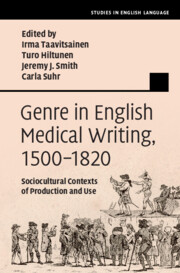Book contents
- Genre in English Medical Writing, 1500–1820
- Studies in English Language
- Genre in English Medical Writing, 1500–1820
- Copyright page
- Contents
- Figures
- Image Gallery
- Tables
- Notes on Contributors
- Preface
- Acknowledgements
- Chapter 1 Medical Discourse and Sociocultural Contexts 1500–1820
- Chapter 2 John Arderne’s Afterlife in Manuscript and Print
- Chapter 3 John Mirfield’s Gouernayl of Helþe
- Chapter 4 Surgical Handbooks Translated into Low German
- Chapter 5 Tracing the Early Modern John of Burgundy
- Chapter 6 The Plague in Southern Italy in 1815–1816
- Chapter 7 On Excitability
- Chapter 8 Systems and Centos
- Chapter 9 Medical Vocabulary in English Romantic Literature
- Chapter 10 Foreign Ingredients in Early and Late Modern English Recipes
- Chapter 11 Walter Bailey’s (1529–1593) Medical Genres
- Chapter 12 London Bills of Mortality of the Seventeenth Century
- Chapter 13 Advertising Proprietary Medicines in Pamphlets
- Chapter 14 Persuasion in Hungarian Medical Recipes
- Chapter 15 Persuasion in Early Modern English Medical Recipes
- Chapter 16 Richard III
- Chapter 17 Images and Paratexts
- Preface to the Image Gallery
- Image Gallery
- Index
- References
Chapter 17 - Images and Paratexts
Published online by Cambridge University Press: 13 October 2022
- Genre in English Medical Writing, 1500–1820
- Studies in English Language
- Genre in English Medical Writing, 1500–1820
- Copyright page
- Contents
- Figures
- Image Gallery
- Tables
- Notes on Contributors
- Preface
- Acknowledgements
- Chapter 1 Medical Discourse and Sociocultural Contexts 1500–1820
- Chapter 2 John Arderne’s Afterlife in Manuscript and Print
- Chapter 3 John Mirfield’s Gouernayl of Helþe
- Chapter 4 Surgical Handbooks Translated into Low German
- Chapter 5 Tracing the Early Modern John of Burgundy
- Chapter 6 The Plague in Southern Italy in 1815–1816
- Chapter 7 On Excitability
- Chapter 8 Systems and Centos
- Chapter 9 Medical Vocabulary in English Romantic Literature
- Chapter 10 Foreign Ingredients in Early and Late Modern English Recipes
- Chapter 11 Walter Bailey’s (1529–1593) Medical Genres
- Chapter 12 London Bills of Mortality of the Seventeenth Century
- Chapter 13 Advertising Proprietary Medicines in Pamphlets
- Chapter 14 Persuasion in Hungarian Medical Recipes
- Chapter 15 Persuasion in Early Modern English Medical Recipes
- Chapter 16 Richard III
- Chapter 17 Images and Paratexts
- Preface to the Image Gallery
- Image Gallery
- Index
- References
Summary
This book, Genre in English Medical Writing, 1500–1820, is adorned with thirty-five figures. Many of these figures are tables or graphs condensing the evidence and arguments of a particular author into forms that can be appreciated better through visualisation. The authors of chapters employing this presentational kind of figure have used their own computer software to generate them. They have no problems other than those involved in designing the book – how best to fit such figures into the layout of the chapter and the pages in which they are found. Other kinds of figure in this book are not presentational in this way but are quite different. These are images chosen by the author, and they reproduce pages in manuscripts or printed books of the early modern era. The author may refer to these images in the text of the chapter as evidence in pursuit of an argument, or choose them as emblems of the kind of things discussed (and so not essential to the argument). Illustrations that do necessary work for the argument of the chapter are found in the chapters by Peter Jones (Chapter 2), Alpo Honkapohja (Chapter 5), and Maura Ratia (Chapter 13). In the last two cases the argument focuses on the ways in which the same or similar textual matter is represented very differently in scribal handiwork, layout, or typography at different dates. The third kind of emblematic figure is there to engage the interest of the reader, giving material form (manuscript or printed) to the genre under discussion in the chapter. This applies to the figures in the Image Gallery, where Figure 2 is an emblem of London in time of plague, Figure 3 an author portrait, and Figure 6 a satire on man-midwifery, all from early modern printed books. The images supplied for these kinds of illustrative figure must first be obtained from professional imaging services or directly from libraries. In extraordinary times of lockdown, as we saw in the Preface to the Image Gallery, there may be difficulties in getting images or permissions.
- Type
- Chapter
- Information
- Genre in English Medical Writing, 1500–1820Sociocultural Contexts of Production and Use, pp. 297 - 301Publisher: Cambridge University PressPrint publication year: 2022

